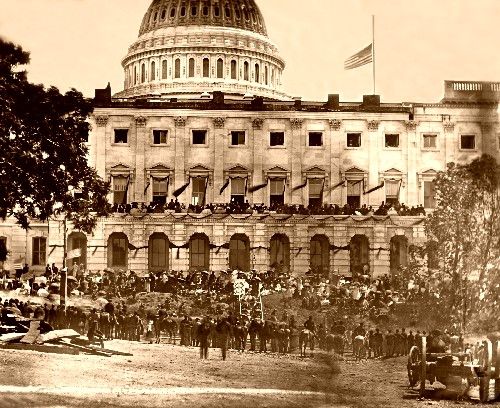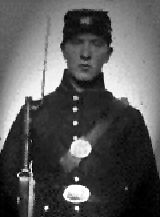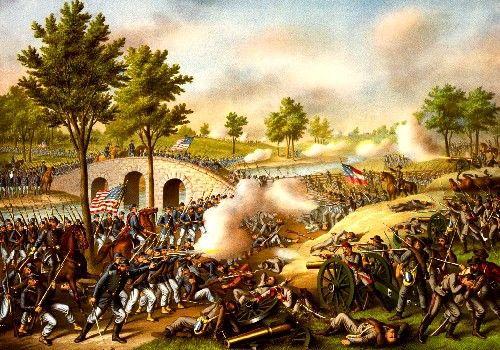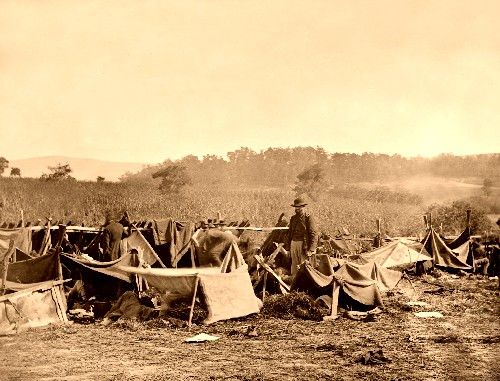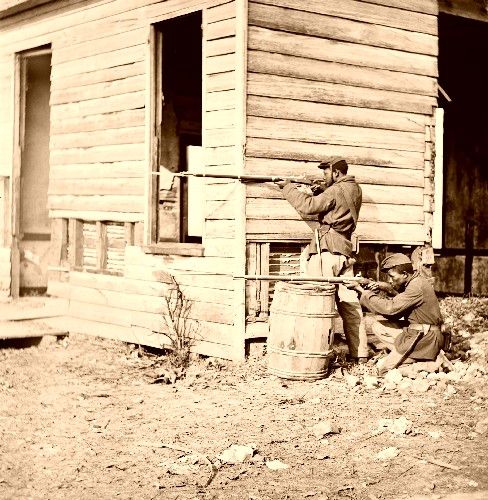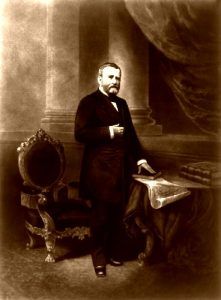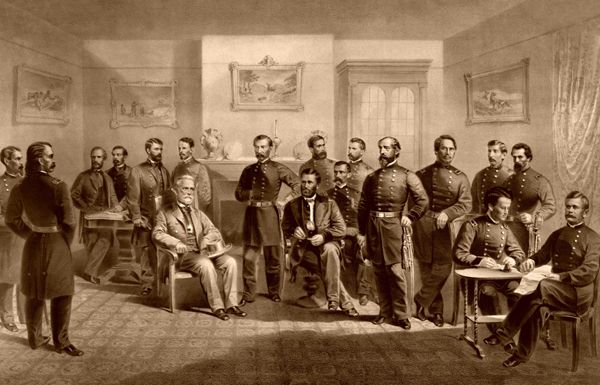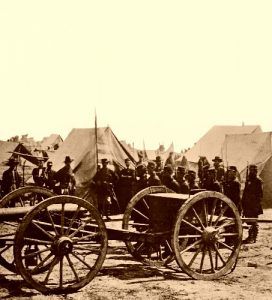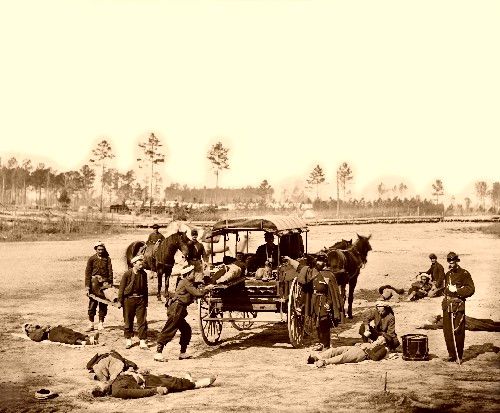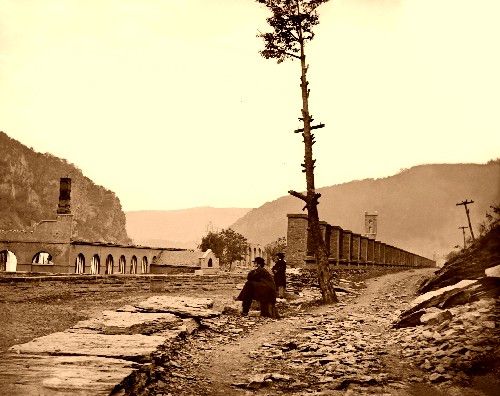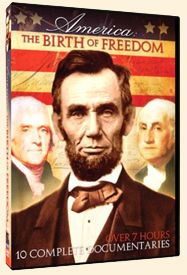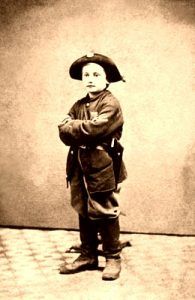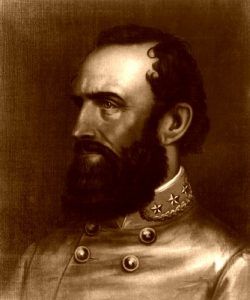“We are not enemies, but friends. We must not be enemies. Though passion may have strained it must not break our bonds of affection. The mystic chords of memory, stretching from every battlefield and patriot grave to every living heart and hearthstone all over this broad land, will yet swell the chorus of the Union, when again touched, as surely they will be, by the better angels of our nature.” — Abraham Lincoln, March 4, 1861, From His First Inaugural Address
~~
More than three million men fought in the Civil War, about 900,000 for the Confederacy and 2.1 million for the Union.
More than 620,000 people, or two percent of the population, died in the Civil War.
Approximately 6,000 battles, skirmishes, and engagements were fought during the Civil War.
An estimated 300 women disguised themselves as men and fought in the ranks.
There were over 2,000 boys who were 14 years old or younger in the Union ranks. Three hundred were 13 years or less, while there were 200,000 no older than 16 years.
At the Battle of Shiloh, on the Tennessee River banks, more Americans fell than in all previous American wars combined. There were 23,700 casualties.
At Fredericksburg, Virginia, in 1862, the Confederate trenches stretched for a distance of seven miles. The troop density was 11,000 per mile or six men to the yard.
3,530 Native Americans fought for the Union, of which 1,018 were killed.
The greatest cavalry battle ever fought in the Western hemisphere was at Brandy Station, Virginia, on June 9, 1863. Nearly 20,000 cavalrymen were engaged on a relatively confined terrain for more than 12 hours.
An Iowa regiment ruled that any man who uttered an oath should read a chapter in the Bible. Several of them got nearly through the Old Testament.
There were more Southern-born Union generals (38) than Northern-born Confederate generals (33).
The famous Confederate blockade-runner, the C.S.S. Alabama never entered a Confederate port during the length of her service.
During the Battle of Antietam, Clara Barton tended the wounded so close to the fighting that a bullet went through her sleeve and killed a man she was treating.
In March 1862, “new” ironclad warships, the Monitor and the Merrimac battled off Hampton Roads, Virginia. From then on, every other wooden navy ship on earth was obsolete.
There were 100 men in a Company and 10 Companies in a Regiment.
Not fond of ceremonies or military music, Ulysses S. Grant said he could only recognize two tunes. “One was Yankee Doodle; the other one wasn’t.”
President Abraham Lincoln was the first president to be assassinated.
Missouri sent 39 regiments to fight in the siege of Vicksburg, Mississippi — 17 to the Confederacy and 22 to the Union.
At the start of the war, the value of all manufactured goods produced in all the Confederate states added up to less than one-fourth of those produced in New York State alone.
In 1862, the U.S. Congress authorized the first paper currency, called “greenbacks.”
Oliver Wendell Holmes, Jr., future chief Justice, was wounded three times during the Civil War — in the chest at Ball’s Bluff, in the back at Antietam, and the heel at Chancellorsville
Surgeons never washed their hands after an operation because all blood was assumed to be the same, nor did he wash their instruments.
Confederate Private Henry Stanley fought for the Sixth Arkansas and was captured at Shiloh, but survived to go to Africa to find Dr. Livingston.
On July 4, 1863, after 48 days of siege, Confederate General John C. Pemberton surrendered Vicksburg, Mississippi, to Union General Ulysses S. Grant. For the next 81 years, Vicksburg, Mississippi, did not celebrate the Fourth of July.
Disease killed twice as many men during the war than did battle wounds.
The 12th Connecticut Regiment entered the war with a complement of 1,000 men. Before it entered its first engagement, sickness had reduced its strength to 600 able-bodied soldiers.
On both sides of the conflict, potential recruits were offered monetary rewards, or “bounties,” for enlisting, as much as $677 in New York. “Bounty jumping” soon became so popular that hundreds of men signed up, and then deserted, to enlist again elsewhere.
For those who were drafted, the law allowed them to pay a substitute to go in their place. Another type of “bounty jumper” was born when men would hire out to more than one draftee and then make a hasty exit once they were paid. The record for bounty jumping was held by John O’Connor, who admitted to hiring himself out 32 times before being caught. He received a four-year prison term.
Though African Americans constituted less than one percent of the northern population, by the war’s end made up ten percent of the Union Army. A total of 180,000 black men, more than 85% of those eligible, enlisted. By the time of the Confederate surrender in 1865, there were more African Americans in the Union army than there were soldiers in the Confederate army.
In November 1863, President Lincoln was invited to offer a “few appropriate remarks” at the opening of a new Union cemetery at Gettysburg. Though Lincoln spoke just 269 words in his Gettysburg Address, the main speaker, an orator from Massachusetts, spoke for nearly two hours.
Confederate General Nathan Bedford Forrest had 30 horses shot from under him and personally killed 31 men in hand-to-hand combat. “I was a horse ahead at the end,” he said.
In 1864, Ulysses S. Grant was promoted to Lieutenant General and led the 533,000 men of the Union Army, the largest in the world. Three years later, he was made President of the United States.
Andersonville Prison in southwest Georgia held 33,000 prisoners in 1864. It was the fifth-largest city in the Confederacy.
Alfred Thomas Archmedes Torbert held commissions in both USA and CSA armies simultaneously.
General Stonewall Jackson walked around with his right hand in the air to balance the blood flow in his body. He thought that his left hand didn’t get as much blood as his right because he was right-handed. So, raising his right hand would allow the excess blood to run into his left. One of his arms has its own grave. Read more about Jackson’s Arm HERE.
The words “In God, We Trust” first appeared on a U.S. coin in 1864.
By the end of the war, Unionists from every state except South Carolina had sent regiments to fight for the North.
On November 9, 1863, President Lincoln attended a theater in Washington, D.C., to see The Marble Heart. In the play was an accomplished actor named John Wilkes Booth.
Hiram Revels of Mississippi became the first black man ever elected to the U.S. Senate. He filled the seat last held by Jefferson Davis.
The 1860 census results show a total population of a little more than 31 million, of which 13% are slaves. Slaves equal 2% of the Northern Aligned States population and 39% in the Southern Aligned States.
On May 13, 1865, a month after Lee’s surrender at Appomattox Court House*, Virginia, Private John J. Williams of the 34th Indiana became the last man killed in the Civil War, in a battle at Palmito Ranch, Texas. The final skirmish was a Confederate victory. (Virginia, at the time, signified county seats by adding Court House to the name of the town. Not to be confused with the building courthouse. It was in the private home of the McLean family that the surrender took place.)
One New York regiment included thirty schoolmasters.
At one time or another, the Northern armies numbered 2,100,000 soldiers. The Southern armies were considerably smaller.
The chance of surviving a wound in the Civil War days was 7 to 1.
About 15 percent of the wounded died in the Civil War.
George Pickett’s doomed infantry charge at Gettysburg was the first time he took his division into combat.
The diseases most prevalent during the Civil War were dysentery, typhoid fever, malaria, pneumonia, arthritis, and the acute diseases of childhood, such as measles, mumps, and malnutrition.
The principal weapon of the war and the one by which 80 percent of all wounds were produced was a single-shot, muzzle-loading rifle in foot soldiers’ hands.
Besides the rifle and cannon, weapons consisted of revolvers, swords, cutlasses, hand grenades, Greek fire, and land mines.
Fully armed, a soldier carried about seven pounds of ammunition, including a cartridge box with 40 rounds. If an extensive battle was anticipated, he might carry an additional 60 rounds.
The muzzle-loading rifle could be loaded at the rate of about three times a minute. Its maximum range was about 1,000 yards.
During the Battle of Antietam, 12,401 Union men were killed, missing, or wounded; it was the bloodiest single day of the Civil War.
Though artillery was used extensively, only about 10 percent of the wounded were the victims of artillery fire.
Many doctors who saw service in the Civil War had never been to medical school but had served an apprenticeship in an established practitioner’s office.
In the battle of Gettysburg, 1,100 ambulances were in use. The Union army’s medical director boasted that all the wounded were picked up from the field within 12 hours after the battle was over. This was a far cry from the second battle of Bull Run when many of the wounded were left on the field in the rain, heat, and sun for three or four days.
Eighty percent of all wounds during the Civil War were in the extremities.
The first U. S. Naval hospital ship, the Red Rover, was used on the inland waters during the Vicksburg campaign.
During the Battle of Murfreesboro, the Union artillery fired 20,307 rounds and the infantry exhausted over 2,000,000 rounds. The total weight of the projectiles fired was more than 375,000 pounds.
At the Battle of First Bull Run or Manassas, between 8,000 and 10,000 bullets were fired for every man killed or wounded.
On March 4, 1865, Lincoln was inaugurated for a second term. Yards away in the crowd was John Wilkes Booth with a pistol in his pocket. His vantage point on the balcony, he said later, offered him “an excellent chance to kill the President, if I had wished.”
General Stonewall Jackson never ate food that tasted good because he assumed that anything that tasted good was completely unhealthy.
In eleven months, the C.S.S. Alabama captured 69 Northern vessels valued at $6,500,000.
At Cold Harbor, Virginia, 7,000 Americans fell in 20 minutes.
Senator John J. Crittendon of Kentucky had two sons who became major generals during the Civil War: one for the North, one for the South.
During the Shenandoah Valley Campaign of 1862, “Stonewall” Jackson marched his force of 16,000 men over 600 miles in 39 days, fighting five major battles and defeating four separate armies totaling 63,000 men.
The first organized ambulance corps were used in the Peninsular campaign and at Antietam.
The U.S.S. Kearsarge sank the C.S.S. Alabama off the coast of Cherbourg, France, in a fierce engagement. Frenchmen gathered along the beach to witness the battle, and Renoir painted the scene, which now hangs in a Philadelphia art gallery.
General Grant’s losses from the Wilderness to Cold Harbor in 1864, a period of 29 days, totaled 54,900.
Besides their captures, Confederate cruisers drove great numbers of U.S. ships under foreign flags for protection, precipitating the U.S. Merchant Marine’s decline.
In the Vicksburg Campaign in 1863, Grant won five battles within a period of 18 days, captured 40 field guns, and inflicted casualties of approximately 5,200 on the South. He captured 31,600 prisoners, 172 cannons, and 6,000 small arms when Vicksburg, Mississippi fell. It was the greatest military haul ever made in the Western hemisphere.
The Confederate cruiser Shenandoah sailed completely around the world, raiding Union whalers and commerce vessels. The ship and its crew surrendered to English authorities in Liverpool more than six months after Lee’s surrender at Appomattox Court House, Va.
There were 6,000,000 cases of disease in the Federal armies, which meant that, on average, every man was sick at least twice.
One small section of Virginia became America’s bloodiest battleground. In an area of barely 20 square miles, including Fredericksburg, Chancellorsville, The Wilderness, Spotsylvania, and Cold Harbor, more than half a million men fought in deadly combat. Here, more men were killed and wounded during the Civil War than were killed and wounded in the Revolutionary War, the War of 1812, the War with Mexico, and all of the Indian wars combined. No fewer than 19 generals, ten Union and nine Confederate met their deaths here.
Lincoln did not believe that whites and blacks could live together in peace. He had planned to relocate the entire black population of the United States to Central America.
Union and Confederate forces stationed at Fredericksburg, Virginia, during the winter of 1862 traded items by constructing small boats and floating them back and forth across the Rappahannock River.
General Robert E. Lee, commander of the Confederate forces, traveled with a pet hen that laid one egg under his cot every morning.
Approximately 130,000 freed slaves became Union soldiers during the war.
The artillery barrage at the Battle of Gettysburg during Pickett’s charge was heard over 100 miles away in Pittsburgh.
The first civilian killed by the abolitionist John Brown and his cohorts at Harper’s Ferry was a free black man.
During the Peninsular Campaign in the spring of 1862, as many as 5,000 wounded were brought into a hospital where only one medical man and five hospital stewards cared for them.
The last land engagement of the Civil War was fought on May 13, 1865, at the Battle of Palmito Ranch in far south Texas, more than a month after General Lee’s surrender at Appomattox Court House.
The largest cavalry battle took place at Brandy Station, Virginia, on June 9, 1863.
Approximately 2,000 men served in the 26th North Carolina Regiment during the course of the Civil War. With Lee’s surrender on April 9, 1865, there were only 131 men left to receive their paroles at Appomattox Court House, Va.
The Confederate forces lost 63 Brigadier Generals, 7 Major Generals, and 3 Lieutenant Generals.
The first military decoration formally authorized by the American government was the Medal of Honor, created by Congress’s act in December 1861. The award was to be given to those members of the armed forces who “shall distinguish themselves by their gallantry in action, and other soldier-like qualities. It was liberally awarded during the Civil War to about 1,200 men.
Black soldiers were paid $10 per month for serving in the Union army, while white soldiers received $13 per month. In June 1864, both got a $3 raise.
In the infantry and artillery units, officers received the following pay at the start of the war:
– Colonels – $212
– Lieutenant Colonels – $181
– Majors – $169
– Captains – $115.50
– Lieutenants – $105.50
Other line and staff officers drew an average of about $15 per month more. Pay for one, two, and three-star generals was $315, $457, and $758, respectively.
Approximately 30,000 Union soldiers died as prisoners of war. The number of Confederate soldiers is estimated at only a little more at 31,000.
More than 3,000 horses were killed at Gettysburg.
The U.S. government estimated in January 1863 that the war was costing $2.5 million per day. A final official estimate in 1879 totaled all expenses at $6,190,000,000. The Confederacy spent an estimated $2,099,808,707.
During the Civil War was the first time that the U.S. Army commissioned chaplains.
In addition to its dead and wounded from battle and disease, the Union listed sunstroke fatalities at 313.
Some authorities accredit the 26th North Carolina Regiment with having incurred the greatest loss in a single battle. At the Battle of Gettysburg, the regiment lost 708 of its men, representing 85 percent of its total strength. In one company of 84 men, every man and officer was hit. The orderly sergeant who made out the report, had a bullet wound through both legs.
In the assault on Petersburg in June 1864, the 1st Maine Heavy Artillery incurred 635 of its 900 men were killed or wounded within seven minutes. Though this organization did not see action until 1864, 1,283 men of its total 2202 were killed or wounded in less than one year.
The Confederate pay structure was modeled after that of the US Army. Privates continued to be paid at the prewar rate of $11 per month until June 1864, when the pay of all enlisted men was raised $18 per month.
If a statue of a person on a horse has both front legs in the air, the person died in battle; if the horse has one front leg in the air, the person died as a result of wounds received in battle; if the horse has all four legs on the ground, the person died of natural causes.
No one knows the identity of the war’s youngest soldier; one Confederate soldier named George S. Lamkin of Winona, Mississippi, joined Stanford’s Mississippi Battery when he was just eleven. He was severely wounded at the Battle of Shiloh.
The bloodiest battles of the War were: Gettysburg – 51,116 casualties in three days; Antietam – 22,726 casualties in one day; and the Seven Days Battle where 36,463 men lost their lives.
Of the 425 Confederate generals, 146 were graduates of West Point.
Almost one-third of the U.S. Army officers resigned to serve the Confederacy.
One regiment of volunteers at Albany, New York, was composed entirely of men over 45 years-old.
During the Civil War, the number of Union deserters is estimated at over 200,000, while deserters from the South are estimated at just a little more than 100,000.
After Gettysburg’s Battle, the discarded rifles were collected and sent to Washington to be inspected and reissued. Of the 37,574 rifles recovered, 24,000 were still loaded.
Missouri sent more men to war, in proportion to her population than any other state. The total number of Missouri Volunteers who served was 199,111.
Thomas Jonathan “Stonewall” Jackson often went about camp handing out Sunday school leaflets.
Most infantry rifles were equipped with bayonets, but very few men wounded by bayonet showed up at hospitals. The conclusion was that the bayonet was not a lethal weapon. The explanation probably lay in the fact that opposing soldiers did not often actually come to grips and, when they did, were prone to use their rifles as clubs.
Thomas Stewart, aged 92 years, of East Newtown, Ohio, was a private in the 101st Ohio regiment and took part in the battle of Perryville, where he was complimented for his bravery and soldierly bearing.
More shells were discharged in Gettysburg’s single battle than were employed in all the battles that Napoleon ever fought.
Compiled and edited by Kathy Weiser-Alexander/Legends of America, updated October 2021.
Also See:

